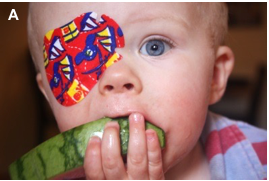Amblyopia, although differing from strabismus, has similar therapies to restore binocular vision in patients. As amblyopia is closely associated with strabismus, correcting the underlying deviation often times resolves the condition. Although closely associated, strabismus and amblyopia are different conditions, often used synonymously, with error, however.
You can learn more about the difference between amblyopia and strabismus here.
Current Treatments for Amblyopia
The most common therapies for amblyopia are occlusion therapy and penalization therapy. These therapeutic modalities are the same in strabismus. Corrective glasses, contact lenses, vision behavioral therapy and, in some extreme cases, surgery may also be helpful. In conditions such as strabismus and cataracts, treating the underlying condition should help improve a person’s amblyopia.

OCCLUSION THERAPY
This method consists of patching the healthy eye to force the weak eye to fixate on an object, subsequently strengthening the affected muscle. Part-time occlusion therapy can be considered to maintain binocular fusion, but full time occlusion may be performed. Read more about occlusion therapy here.
PENALIZATION THERAPY
Just as occlusion therapy, penalization limits the work of the healthy eye and increases the workload of the weak eye. It is effective by blurring the image instead of completely occluding it. Blurring the non-affected eye can be done optically or with atropine drops, which causes pupillary dilation, blurred vision, and possible photophobia. Read more about penalization therapy here.
CORRECTIVE LENSES
These are often used as a first line treatment for mild strabismus correction. These lenses differ based on need, ranging from refractive spectacles for farsightedness to prismatic optics which may redirect distorted diplopia into proper binocular sync.
BEHAVIORAL THERAPY
Requires the patient to be acutely aware of their position in respect to the objects they are viewing, forcing the weak eye to fixate, secondarily strengthening the weak extraocular muscle to increase binocular fusion.
INVASIVE THERAPY
Surgical intervention along with botox therapy are considered more invasive procedures to correct amblyopia. Both of these procedures require experienced physician precision and often in child hospitalization and sedation. These are therapeutic options for correcting amblyopia associated with strabismus, which is, anatomical misalignment of the eyes leading to secondary amblyopia. To learn more read about surgery and botox therapy.



